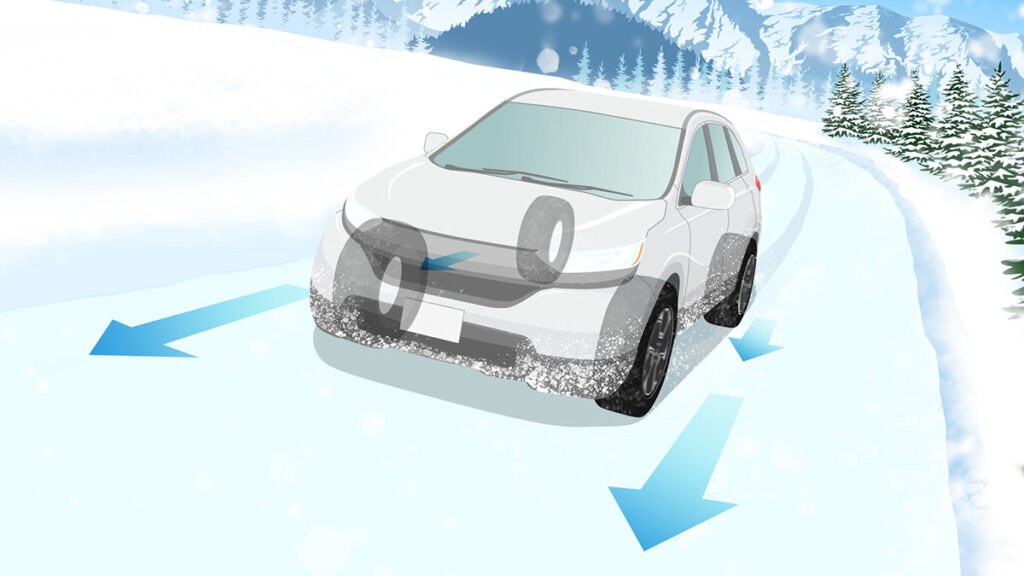Introduction
All wheel drive (AWD), four-wheel drive (4WD), front wheel drive (FWD) and rear wheel drive (RWD) are all examples of different drivetrains, or ways of transferring the power of the engine to the wheels. Each of these different drivetrains have their own benefits and detriments, which we will discuss here. Sometimes hearing all these different terms thrown around can become overwhelming, but worry not, they are all quite simple in nature.
Front Wheel Drive (FWD)

This is perhaps the most common drive train found in todays world. In this setup, the power from the engine is sent to the front wheels only. Depending on the differential, power can be sent to both or one of the front wheels (see our article on limited slip differentials here).
Front wheel drive performs well in all but the most extreme weather conditions and is usually more fuel efficient than all or four-wheel drive (as only 2 wheels are powered instead of four). This makes it ideal for daily driving, some of the most popular cars in the world are front wheel drive (though not the most exciting). It performs very well in the snow because there is a large amount of weight over the front wheels. Assuming that the vehicle has its engine in the front, this means that the entire weight of the engine is pressing down on the front wheels which gives them more traction. In contrast, a rear-wheel-drive drivetrain would have far less success in the snow as there is very little weight over the rear wheels (assuming the engine is in the front of the vehicle).
Most cheap economy cars are front wheel drive, it actually delivers exactly what you would want from a reliable economy car. Front wheel drive is fuel efficient, can handle most weather conditions well and is cheaper to implement than other drivetrains. That being said, there are a few performance cars that are front wheel drive, the most popular ones are produced by Honda, namely the Civic Si and Civic Type R. The Civic Si is actually a car that I hope to own as a daily in the near future (read more about the Civic Si in this article I wrote here). When paired with a good limited slip differential, front wheel drive can actually perform very well, though it likely wouldn’t be able to compete with a well tuned all or rear wheel drive drivetrain. The biggest challenge that front wheel drive faces when it comes to performance is that the front wheels are responsible for both putting power down and steering, whereas in other drivetrains putting the power down is transferred to or shared with the other wheels.
To summarize, front wheel drive is cheap, fuel efficient, and performs well in nearly all weather conditions which makes it a great choice for daily driving.
Rear Wheel Drive (RWD)

Rear wheel drive is a drivetrain that is most commonly found in sports cars, in fact muscle cars are almost exclusively rear wheel drive. For example, the Corvette, Mustang, Camaro, Charger (V8 models) and Challenger are all rear wheel drive. Rear wheel drive is also used in some of the greatest track cars of all time as well, namely the Mercedes AMG GT R, Porsche 911 GT3 RS, Dodge Viper ACR and Lamborghini Huracan STO (read all about these cars in this article here).
Rear wheel drive is vastly superior to front wheel drive and four-wheel drive when it comes to performance, all wheel drive is the only drivetrain that can compare in this aspect. Rear wheel drive allows for a vehicle to have a better weight distribution (closer to 50-50) than front wheel drive. Front wheel drive vehicles must store the differential and much of the drivetrain in the front of the vehicle with the engine, whereas a rear-wheel-drive vehicle will store the differential, axels and other heavy drivetrain components in the rear. A more equal weight distribution increases the stability of the vehicle and can allow it to take turns faster. By extension, rear wheel drive vehicles have more space in the engine bay (as the drivetrain components are moved to the rear) and can accommodate larger engines. Additionally, in a front wheel drive vehicle there is significant stress on the front tires during turns, as they are responsible both for accelerating and steering. Whereas in a rear-wheel-drive vehicle, the front wheels are only responsible for steering and the rear wheels are responsible for acceleration, this allows for rear-wheel-drive vehicles to take turns considerably faster than front wheel drive vehicles.
Although rear wheel drive does offer significant performance gains, it has some cons as well. It simply cannot compete with any of the other drivetrains in this article when it comes to driving in inclement weather conditions. Unlike front wheel drive, in a rear-wheel-drive vehicle there is very little weight over the rear wheels (assuming that the engine is in the front of the vehicle), which therefore reduces traction. There are millions of videos online that show what its like to drive a rear-wheel-drive vehicle in the winter, and just as many reddit posts of people advising against it. Many rear-wheel-drive cars can spin out in slightly wet roads unless they have appropriate tires on.
In summary, rear wheel drive is great for track performance but does not perform well in inclement weather, making it ideal for sports cars but not for daily drivers.
All Wheel Drive (AWD)

After reading the previous sections you may begin to think that you can either have a drivetrain that performs well on the track (RWD) or well in adverse weather conditions (FWD), but not both. However, all wheel drive (AWD) is here to dispel that notion, offering the best of both worlds.
All wheel drive is arguably the most complicated drive train listed in this article. It is a drivetrain that allows for power to be sent to both the front and rear wheels at the same time in differing amounts. Depending on the differentials in the vehicle, sometimes the power sent to each wheel can individually be adjusted as well. This provides excellent performance in adverse weather conditions, as all four tires receive power at the same time. This alone gives it an advantage over RWD and FWD in poor weather conditions, as they only send power to 2 wheels at a time. Additionally, AWD drivetrains are tunable, they can have different settings for different weather conditions which change their behaviour.
This also allows AWD drivetrains to typically outperform FWD drivetrains on the track, but not necessarily RWD drivetrains. AWD drivetrains do still suffer from the same issue as FWD on the track, where the front wheels are still required to both steer and put power down. AWD drivetrains also have several additional components over RWD drivetrains, as both sets of wheels must be able to receive power, this adds a significant amount of weight. In ideal weather conditions, this additional weight and potential for oversteer will typically allow RWD to outperform AWD on the track. One final point I would like to make is that in dig racing (drag racing from a stand still) on a regular street (with no track prep), AWD will outperform RWD almost every time. This is because sending power to all four tires greatly increases traction, allowing for AWD vehicles to accelerate extremely quickly from a standstill.
Overall, this is typically the most desirable drivetrain to have in a daily driver as it can perform quite well on the track but also handle well in adverse weather conditions. The only real advantage that FWD has over AWD is reduced fuel consumption, sending power to all four tires will typically cause AWD drivetrains to consume more fuel than FWD drivetrains. However, it is worth noting that most AWD drivetrains revert to a form of two-wheel drive when cruising to reduce fuel consumption.
Four Wheel Drive (4WD)

Four-wheel drive is the final drivetrain on this list and is somewhat unique, in the sense that it is distinctly different from the other drivetrains on the list. It is almost exclusively reserved for extreme off-roading and is the king of off-road performance. It locks the front and rear driveshafts together, which forces the front and rear axels to rotate at the same speed, locking differentials can be employed to force each wheel to rotate at the same speed as well.
The above paragraph may have made the one major drawback of 4WD drivetrains apparent. During a turn, which one must frequently make while driving, the wheels must rotate at different speeds, but a 4WD drivetrain does not allow for that. Therefore, the biggest drawback of 4WD drivetrains is that they are not suitable for use on normal roads, only on loose surfaces where the tires can slide during turns. But in truly adverse conditions, such as deep snow, this will outperform other drivetrains, the only one that can come close to matching it is AWD.
4WD shines in extreme off-roading conditions, forcing power to each wheel can aid in getting a vehicle unstuck or through loose ground. Some drivetrains may fail if they feel that no wheel has any traction, whereas 4WD can brute force its way out of messes by forcefully sending power to each wheel. A second major downside of 4WD is that it will consume more fuel than other drivetrains, though it doesn’t need to be engaged all the time (it is an optional mode on most vehicles).
In my opinion, the average person may never see conditions extreme enough to warrant 4WD, which forces me to conclude that the vast majority of people would not benefit from having a 4WD drivetrain over an AWD drivetrain. Any of the other drivetrains would offer far superior capability for daily driving as well.
Sources: MotorTrend, Car and Driver, Edmunds, Car Tyres, Global Honda, Carscoops, Auto Express, Anaconda



